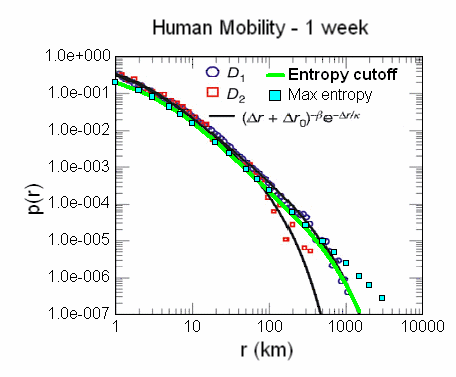The Stretched Exponential
I would not use the stretched exponential because its derivation involves a disordered superposition of damped exponentials where only the time constant gets varied. In the dispersion that I care about, I take the velocity as the primary disperser, and only disperse the time constants if we have an additional waiting time distribution to consider.
I will toss a diagram up here as an interesting experiment. For example the idea of the human mobility plot that I refer to in my recent cross-posted TOD article has an exceedingly simple rationalization. I have the derived equation that gives the probabilities of how far people have moved in a certain time, based on the dispersion principle.
P(x,t) = beta/(beta + x/t)

To simulate this behavior is really beyond simple. You simply have to draw from a uniform random distribution for distance (x) and then draw another number for a random time span (t). Or you can do it from two inverted MaxEnt exponential draws (doesn't really matter apart from the statistics). You then divide the two to arrive at a random velocity, i.e. v=x/t. Nothing more simple than this formula or formulation. The ranked histogram for the Monte Carlo simulation of 10,000,000 trials of independent draws looks like the following points with the dispersion formula in red:

Where else does the stretched exponential get some top billing? Well, it turns out by taking the complementary cumulative of the stretched exponential, you get the Weibull distribution. And the reason I don't use the Weibull follows from the same basic concern. The Weibull when applied in such areas as bathtub curve for reliability analysis also deals with a superposition of time constants, and not velocity, the latter which I think makes much more pragmatic sense. I suggest that the active velocity of creep and heat and other factors affect failure much more than passive abstractions such as a varying set of time constants.
http://mobjectivist.blogspot.com/2009/10/creep-failure.html
http://mobjectivist.blogspot.com/2009/10/failure-is-complement-of-success.html
I became motivated to write this post up due to the 1998 paper by J.H.Laherrère and D.Sornette, "Stretched exponential distributions in nature and economy: fat tails with characteristic scales", European Physical Journal B 2, April II, p525-539 : in arXiv. They have some very interesting ideas and useful heuristic approximations, but I want to make a claim and drive a stake in the ground that I use a completely inverted analysis than the stretched exponential and parabolic fractal crowd apply to their own interpretation. Velocity, not time, drives these behaviors, and no one seems to want to pursue that angle.
You can describe both he stretched exponential and the dispersive formulation as fat-tailed distributions, but the dispersive remains the phattest. At least until something better comes along.









0 Comments:
Post a Comment
<< Home